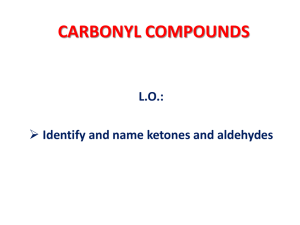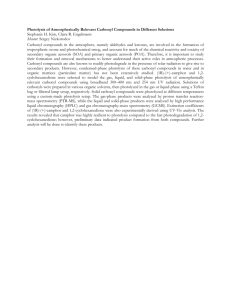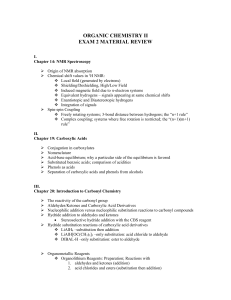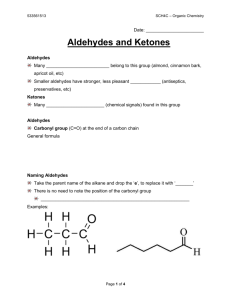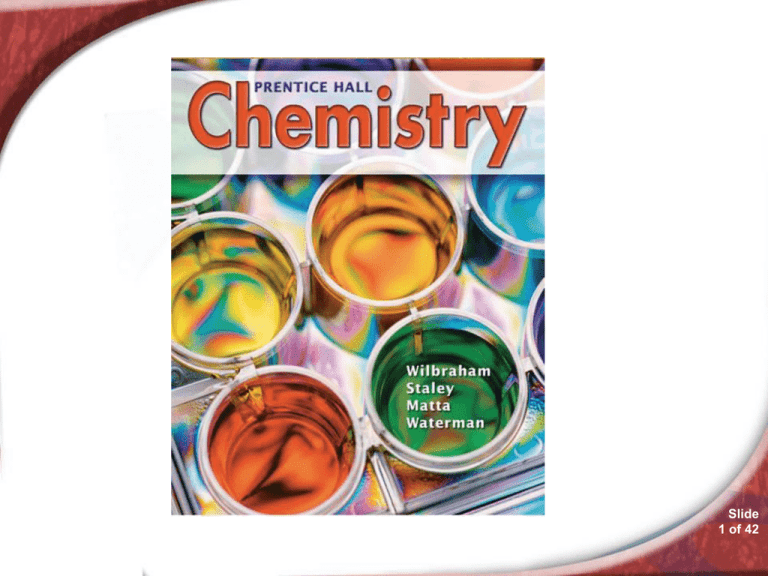
chemistry
Slide
1 of 42
23.3
Carbonyl Compounds
Have you heard of
benzaldehyde or vanillin? It is
likely that you have eaten
these organic molecules,
called aldehydes, in ice cream
or cookies. You will read about
the properties that are
associated with carbonyl
compounds, such as
aldehydes.
Slide
2 of 42
© Copyright Pearson Prentice Hall
23.3
Carbonyl Compounds
>
Aldehydes and Ketones
Aldehydes and Ketones
What is the structure of a carbonyl
group found in aldehydes and ketones?
Slide
3 of 42
© Copyright Pearson Prentice Hall
23.3
Carbonyl Compounds
>
Aldehydes and Ketones
A carbonyl group is a functional group with the
general structure C═O.
The C═O functional group is present in
aldehydes and ketones.
Slide
4 of 42
© Copyright Pearson Prentice Hall
23.3
Carbonyl Compounds
>
Aldehydes and Ketones
An aldehyde is an organic compound in which
the carbon of the carbonyl group is always joined
to at least one hydrogen.
Slide
5 of 42
© Copyright Pearson Prentice Hall
23.3
Carbonyl Compounds
>
Aldehydes and Ketones
A ketone is an organic compound in which the
carbon of the carbonyl group is joined to two
other carbons.
Slide
6 of 42
© Copyright Pearson Prentice Hall
23.3
Carbonyl Compounds
>
Aldehydes and Ketones
Slide
7 of 42
© Copyright Pearson Prentice Hall
23.3
Carbonyl Compounds
>
Aldehydes and Ketones
Slide
8 of 42
© Copyright Pearson Prentice Hall
23.3
Carbonyl Compounds
>
Aldehydes and Ketones
Properties of Aldehydes and Ketones
Slide
9 of 42
© Copyright Pearson Prentice Hall
23.3
Carbonyl Compounds
>
Aldehydes and Ketones
Uses of Aldehydes and Ketones
Many aldehydes and ketones have distinctive
odors.
• Aromatic aldehydes are often used as
flavoring agents.
• Benzaldehyde is known as oil of bitter
almond.
• Cinnamaldehyde is the source of the odor of
oil of cinnamon.
Slide
10 of 42
© Copyright Pearson Prentice Hall
23.3
Carbonyl Compounds
>
Aldehydes and Ketones
Vanillin, an aldehyde, comes from vanilla beans.
Slide
11 of 42
© Copyright Pearson Prentice Hall
23.3
Carbonyl Compounds
>
Aldehydes and Ketones
A solvent used to remove nail polish is acetone,
a ketone.
Slide
12 of 42
© Copyright Pearson Prentice Hall
23.3
Carbonyl Compounds
>
Carboxylic Acids
Carboxylic Acids
What is the general formula for a
carboxylic acid?
Slide
13 of 42
© Copyright Pearson Prentice Hall
23.3
Carbonyl Compounds
>
Carboxylic Acids
• A carboxyl group consists of a carbonyl
group attached to a hydroxyl group.
• A carboxylic acid is a compound with a
carboxyl group.
Slide
14 of 42
© Copyright Pearson Prentice Hall
23.3
Carbonyl Compounds
>
Carboxylic Acids
The general formula for a carboxylic acid
is RCOOH.
Carboxylic acids are weak because they
ionize slightly in solution to give a
carboxylate ion and a hydrogen ion.
Slide
15 of 42
© Copyright Pearson Prentice Hall
23.3
Carbonyl Compounds
>
Carboxylic Acids
Carboxylic acids give a variety of foods—
spoiled as well as fresh—a distinctive sour
taste.
Slide
16 of 42
© Copyright Pearson Prentice Hall
23.3
Carbonyl Compounds
>
Carboxylic Acids
• Low-molar-mass carboxylic acids are volatile
liquids with sharp, unpleasant odors.
• The higher-mass carboxylic acids are
nonvolatile, waxy, odorless solids with low
melting points.
Slide
17 of 42
© Copyright Pearson Prentice Hall
23.3
Carbonyl Compounds
>
Carboxylic Acids
• Many continuous-chain carboxylic acids
were first isolated from fats and are called
fatty acids.
• Stearic acid, an 18-carbon acid obtained
from beef fat, is used to make inexpensive
wax candles.
Slide
18 of 42
© Copyright Pearson Prentice Hall
23.3
Carbonyl Compounds
>
Carboxylic Acids
Slide
19 of 42
© Copyright Pearson Prentice Hall
23.3
Carbonyl Compounds
>
Esters
Esters
What is the general structure
of an ester?
Slide
20 of 42
© Copyright Pearson Prentice Hall
23.3
Carbonyl Compounds
>
Esters
Esters contain a carbonyl group and an
ether link to the carbonyl carbon. The
general formula for an ester is RCOOR.
Slide
21 of 42
© Copyright Pearson Prentice Hall
23.3
Carbonyl Compounds
>
Esters
Esters are derivatives of carboxylic acids in
which the —OH of the carboxyl group has been
replaced by an —OR from an alcohol.
Slide
22 of 42
© Copyright Pearson Prentice Hall
23.3
Carbonyl Compounds
>
Esters
Esters may be prepared from a carboxylic acid
and an alcohol.
Slide
23 of 42
© Copyright Pearson Prentice Hall
23.3
Carbonyl Compounds
>
Esters
Slide
24 of 42
© Copyright Pearson Prentice Hall
23.3
Carbonyl Compounds
>
Esters
Slide
25 of 42
© Copyright Pearson Prentice Hall
23.3
Carbonyl Compounds
>
Esters
Ethyl ethanoate is a low-molar-mass ester.
Slide
26 of 42
© Copyright Pearson Prentice Hall
23.3
Carbonyl Compounds
>
Esters
Esters impart the characteristic aromas and
flavors of many flowers and fruits. Marigolds,
raspberries, and bananas all contain esters.
Slide
27 of 42
© Copyright Pearson Prentice Hall
23.3
Carbonyl Compounds
>
Oxidation-Reduction Reactions
Oxidation-Reduction Reactions
Why is dehydrogenation an oxidation
reaction?
Slide
28 of 42
© Copyright Pearson Prentice Hall
23.3
Carbonyl Compounds
>
Oxidation-Reduction Reactions
The loss of hydrogen is a dehydrogenation
reaction.
Dehydrogenation is an oxidation
reaction because the loss of each
molecule of hydrogen involves the loss
of two electrons from the organic
molecule.
Slide
29 of 42
© Copyright Pearson Prentice Hall
23.3
Carbonyl Compounds
>
Oxidation-Reduction Reactions
Slide
30 of 42
© Copyright Pearson Prentice Hall
23.3
Carbonyl Compounds
>
Oxidation-Reduction Reactions
Slide
31 of 42
© Copyright Pearson Prentice Hall
23.3
Carbonyl Compounds
>
Oxidation-Reduction Reactions
Slide
32 of 42
© Copyright Pearson Prentice Hall
23.3
Carbonyl Compounds
>
Oxidation-Reduction Reactions
Energy produced by oxidation reactions is used
in both living and nonliving systems.
Slide
33 of 42
© Copyright Pearson Prentice Hall
23.3
Carbonyl Compounds
>
Oxidation-Reduction Reactions
Slide
34 of 42
© Copyright Pearson Prentice Hall
23.3
Carbonyl Compounds
>
Oxidation-Reduction Reactions
Slide
35 of 42
© Copyright Pearson Prentice Hall
23.3
Carbonyl Compounds
>
Oxidation-Reduction Reactions
Slide
36 of 42
© Copyright Pearson Prentice Hall
23.3
Carbonyl Compounds
>
Oxidation-Reduction Reactions
An aldehyde is mixed with Fehling’s reagent (left
test tube) and heated. The blue copper(II) ions in
Fehling’s reagent are reduced to form Cu2O, a
red precipitate (right test tube).
Slide
37 of 42
© Copyright Pearson Prentice Hall
23.3 Section Quiz.
Assess students’ understanding
of the concepts in Section 23.3.
Continue to:
-or-
Launch:
Section Quiz
Slide
38 of 42
© Copyright Pearson Prentice Hall
23.3 Section Quiz
1. Which compound is a ketone?
a. CH3COOH
b. CH3CH2OH
c. CH3CHO
d. CH3COCH3
Slide
39 of 42
© Copyright Pearson Prentice Hall
23.3 Section Quiz.
2. The IUPAC name for the structure
CH3CH2COOH is
a. ethanoic acid.
b. acetic acid.
c. propanoic acid.
d. propionic acid.
Slide
40 of 42
© Copyright Pearson Prentice Hall
23.3 Section Quiz.
3. The product of the reaction between an
alcohol and a carboxylic acid is called
a. a ketone.
b. an ether.
c. an ester.
d. an aldehyde.
Slide
41 of 42
© Copyright Pearson Prentice Hall
23.3 Section Quiz.
4. Choose the correct words for the spaces.
Dehydrogenation is __________ reaction
because losing a molecule of hydrogen
involves the _______________ electrons
from the organic molecule.
a. an oxidation, loss of two
b. an oxidation, loss of four
c. a reduction, gain of two
d. a reduction, gain of four
© Copyright Pearson Prentice Hall
Slide
42 of 42
END OF SHOW


